Hydrological Climate Change Impact Assessment at Small and Large Scales: Key Messages from Recent Progress in Sweden
Abstract
:1. Introduction
2. Hydrological Impacts of Climate Change: State of the Art
- Climate modelling. AOGCMs are used to make future climate projections, which are commonly dynamically downscaled by RCMs.
- Tailoring and hydrological modelling. Simulations with hydrological models, commonly preceded by tailoring of the GCM or RCM output. This tailoring may include bias-adjustment and/or downscaling.
- Impact assessment. The results are post-processed in statistical analysis, to be useful as decision support to various societal sectors. They are also analysed to attribute hydrological processes and assess the importance of CC in relation to other changes, in order to optimize adaptation measures.
2.1. Climate Modelling
2.2. Tailoring and Hydrological Modelling
2.2.1. Hydrological Processes and Modelling at the Small Scale
2.2.2. Hydrological Processes and Modelling at the Large Scale
2.3. Impact Assessment
3. Progress at the Small Scale
3.1. Progress in Climate Modelling at the Small Scale
3.2. Progress in Tailoring and Hydrological Modelling at the Small Scale
3.3. Progress in Impact Assessment at the Small Scale
4. Progress at the Large Scale
4.1. Progress in Climate Modelling at the Large Scale
4.2. Progress in Tailoring and Hydrological Modelling at the Large Scale
4.3. Progress in Impact Assessment at the Large Scale
5. Concluding Remarks
- Climate modelling: Hydrological impacts are expected on widely different scales. This fact places high demands on the climate models that need to reproduce both large-scale synoptic patterns (e.g., atmospheric teleconnections) and small-scale local variability (e.g., short-duration precipitation extremes).
- Tailoring and hydrological modelling: Tailoring (bias-adjustment and/or downscaling) of the climate model output prior to hydrological simulation is critical. The methods used need to be highly flexible and applied at the right scales in time and space, may be sensitive to the choice of reference data, and may modify CC signals. Hydrological impacts are further sensitive to geographical and meteorological data used in the modelling process.
- Impact assessment: CC will undoubtedly play a major role in shaping future hydrology at all scales. However, these changes may be equalled or even exceeded by the impacts of man-made interventions related to e.g., urbanization, infrastructure, air pollution emissions, agricultural practices, and hydropower management.
Acknowledgments
Author Contributions
Conflicts of Interest
References
- Field, C.B.; Barros, V.; Stocker, T.F.; Qin, D.; Dokken, D.J.; Ebi, K.L.; Mastrandrea, M.D.; Mach, K.J.; Plattner, G.-K.; Allen, S.K.; et al. Managing the Risks of Extreme Events and Disasters to Advance Climate Change Adaptation—A Special Report of Working Groups I and II of the Intergovernmental Panel on Climate Change; Cambridge University Press: Cambridge, UK, 2012; p. 582. [Google Scholar]
- Greve, P.; Orlowsky, B.; Mueller, B.; Sheffield, J.; Reichstein, M.; Seneviratne, S.I. Global assessment of trends in wetting and drying over land. Nat. Geosci. 2014, 7, 716–721. [Google Scholar] [CrossRef]
- Bergström, S.; Carlsson, B.; Gardelin, M.; Lindström, G.; Pettersson, A.; Rummukainen, M. Climate change impacts on runoff in Sweden—Assessments by global climate models, dynamical downscaling and hydrological modelling. Clim. Res. 2001, 16, 101–112. [Google Scholar] [CrossRef]
- Andréasson, J.; Bergström, S.; Carlsson, B.; Graham, L.P.; Lindström, G. Hydrological change—Climate change impact simulations for Sweden. AMBIO 2004, 33, 228–234. [Google Scholar] [CrossRef] [PubMed]
- Arheimer, B.; Lindström, G. Climate impact on floods: Changes in high flows in Sweden in the past and the future (1911–2100). Hydrol. Earth Syst. Sci. 2015, 19, 771–784. [Google Scholar] [CrossRef]
- Wilby, R.L.; Wigley, T.; Conway, D.; Jones, P.; Hewitson, B.; Main, J.; Wilks, D. Statistical downscaling of general circulation model output: A comparison of methods. Water Resour. Res. 1998, 34, 2995–3008. [Google Scholar] [CrossRef]
- Wood, A.W.; Leung, L.R.; Sridhar, V.; Lettenmaier, D.P. Hydrologic implications of dynamical and statistical approaches to downscaling climate model outputs. Clim. Chang. 2004, 64, 189–216. [Google Scholar] [CrossRef]
- Yang, W.; Andréasson, J.; Graham, L.P.; Olsson, J.; Rosberg, J.; Wetterhall, F. Distribution based scaling to improve usability of regional climate model projections for hydrological climate change impacts studies. Hydrol. Res. 2010, 41, 211–229. [Google Scholar] [CrossRef]
- Teutschbein, C.; Seibert, J. Bias correction of regional climate model simulations for hydrological climate-change impact studies: Review and evaluation of different methods. J. Hydrol. 2012, 456–457, 12–29. [Google Scholar] [CrossRef]
- Bosshard, T.; Carambia, M.; Goergen, K.; Kotlarski, S.; Krahe, P.; Zappa, M.; Schär, C. Quantifying uncertainty sources in an ensemble of hydrological climate-impact projections. Water Resour. Res. 2013, 49, 1523–1536. [Google Scholar] [CrossRef]
- Berg, P.; Bosshard, T.; Yang, W. Model consistent pseudo-observations of precipitation and their use for bias correcting regional climate models. Climate 2015, 3, 118–132. [Google Scholar] [CrossRef]
- Willems, P.; Olsson, J.; Arnbjerg-Nielsen, K.; Beechams, S.; Pahirana, A.; Buelow Gregersen, I.; Madsen, H.; Nguyen, V.T.V. Impacts of Climate Change on Rainfall Extremes and Urban Drainage Systems; IWA Publishing: London, UK, 2012. [Google Scholar]
- Taylor, K.E.; Stouffer, R.J.; Meehl, G.A. An overview of CMIP5 and the experiment design. Bull. Am. Meteor. Soc. 2012, 93, 485–498. [Google Scholar] [CrossRef]
- Meehl, G.A.; Teng, H.; Arblaster, J.M. Climate model simulations of the observed early-2000s hiatus of global warming. Nat. Clim. Chang. 2014, 4, 898–902. [Google Scholar] [CrossRef]
- Gonzalez, P.L.M.; Goddard, L. Long-lead ENSO predictability from CMIP5 decadal hindcasts. Clim. Dyn. 2016, 46, 3127–3147. [Google Scholar] [CrossRef]
- Christensen, J.H.; Carter, T.R.; Rummukainen, M.; Amanatidis, G. Evaluating the performance and utility of regional climate models: The PRUDENCE project. Clim. Chang. 2007, 81, 1–6. [Google Scholar] [CrossRef]
- Van der Linden, P.; Mitchell, J.F.B. ENSEMBLES: Climate Change and Its Impacts: Summary of Research and Results from the ENSEMBLES Project; UK Met Office Hadley Centre: Exeter, UK, 2009; p. 160.
- Mearns, L.O.; Gutowski, W.; Jones, R.; Leung, R.; McGinnis, S.; Nunes, A.; Qian, Y. A regional climate change assessment program for North America. Eos Trans. AGU 2009, 90, 311. [Google Scholar] [CrossRef]
- Menéndez, C.G.; de Castro, M.; Sorensson, A.; Boulanger, J.-P. CLARIS project: Towards climate downscaling in South America. Meteorol. Z. 2010, 19, 357–362. [Google Scholar] [CrossRef]
- Giorgi, F.; Jones, C.; Asrar, G.R. Addressing climate information needs at the regional level: The CORDEX framework. WMO Bull. 2009, 58, 175–183. [Google Scholar]
- Jones, C.G.; Giorgi, F.; Asrar, G. The coordinated regional downscaling experiment CORDEX: An. international downscaling link to CMIP5. CLIVAR Exch. 2011, 56, 34–40. [Google Scholar]
- Jacob, D.; Petersen, J.; Eggert, B.; Alias, A.; Christensen, O.B.; Bouwer, L.M.; Braun, A.; Colette, A.; Déqué, M.; Georgievski, G.; et al. EURO-CORDEX: New high-resolution climate change projections for European impact research. Reg. Environ. Chang. 2013, 14, 563–578. [Google Scholar] [CrossRef]
- Vautard, R.; Gobiet, A.; Jacob, D.; Belda, M.; Colette, A.; Déqué, M.; Fernández, J.; García-Díez, M.; Goergen, K.; Güttler, I.; et al. The simulation of European heat waves from an ensemble of regional climate models within the EURO-CORDEX project. Clim. Dyn. 2013, 41, 2555–2575. [Google Scholar] [CrossRef]
- Kotlarski, S.; Keuler, K.; Christensen, O.B.; Colette, A.; Déqué, M.; Gobiet, A.; Goergen, K.; Jacob, D.; Lüthi, D.; van Meijgaard, E.; et al. Regional climate modeling on European scales: A joint standard evaluation of the EURO-CORDEX RCM ensemble. Geosci. Model. Dev. 2014, 7, 1297–1333. [Google Scholar] [CrossRef]
- Vautard, R.; Gobiet, A.; Sobolowski, S.; Kjellström, E.; Stegehuis, A.; Watkiss, P.; Mendlik, T.; Landgren, O.; Nikulin, G.; Teichmann, C.; et al. The European climate under a 2 °C global warming. Environ. Res. Lett. 2014, 9, 034006. [Google Scholar] [CrossRef]
- Giorgi, F.; Marinucci, M.R. Improvements in the simulation of surface climatology over the European region with a nested modelling system. Geophys. Res. Lett. 1996, 23, 273–276. [Google Scholar] [CrossRef]
- Samuelsson, P.; Jones, C.; Willén, U.; Ullerstig, A.; Gollvik, S.; Hansson, U.; Jansson, C.; Kjellström, E.; Nikulin, G.; Wyser, K. The Rossby Centre Regional Climate Model RCA3: Model description and performance. Tellus 2011, 63, 4–23. [Google Scholar] [CrossRef]
- Adam, J.C.; Lettenmaier, D.P. Adjustment of global gridded precipitation for systematic bias. J. Geophys. Res. 2003, 108, 4257. [Google Scholar] [CrossRef]
- Kauffeldt, A.; Halldin, S.; Rodhe, A.; Xu, C.-Y.; Westerberg, I.K. Disinformative data in large-scale hydrological modelling. Hydrol. Earth Syst. Sci. 2013, 17, 2845–2857. [Google Scholar] [CrossRef]
- Yang, W.; Gardelin, M.; Olsson, J.; Bosshard, T. Multi-variable bias correction: Application of forest fire risk in present and future climate in Sweden. Nat. Hazards Earth Syst. Sci. 2015, 15, 2037–2057. [Google Scholar] [CrossRef]
- Hay, L.E.; Wilby, R.L.; Leavesley, G.H. A comparison of delta change and downscaled GCM scenarios for three mountainous basins in the United States. J. Am. Water Resour. Assoc. 2000, 36, 387–398. [Google Scholar] [CrossRef]
- Maraun, D.; Wetterhall, F.; Ireson, A.M.; Chandler, R.E.; Kendon, E.J.; Widmann, M.; Brienen, S.; Rust, H.W.; Sauter, T.; Themel, M.; et al. Precipitation downscaling under climate change. Recent developments to bridge the gap between dynamical models and the end user. Rev. Geophys. 2010, 48, RG3003. [Google Scholar] [CrossRef]
- Bastola, S.; Murphy, C.; Sweeney, J. The role of hydrological modelling uncertainties in climate change impact assessments of Irish river catchments. Adv. Water Res. 2011, 34, 562–576. [Google Scholar] [CrossRef]
- Roudier, P.; Andersson, J.C.M.; Donnelly, C.; Feyen, L.; Greuell, W.; Ludwig, F. Projections of future floods and hydrological droughts in Europe under a +2 °C global warming. Clim. Chang. 2016, 135, 341–355. [Google Scholar] [CrossRef]
- Van Vliet, M.; Donnelly, C.; Strömbäck, L.; Capell, R. European scale climate information services for water use sectors. J. Hydrol. 2015, 528, 503–513. [Google Scholar] [CrossRef]
- Richards, L.A. Capillary conduction of liquids through porous mediums. J. Appl. Phys. 1931, 1, 318–333. [Google Scholar] [CrossRef]
- Sharma, M.L.; Taniguchi, M. Movement of a non-reactive solute tracer during steady and intermittent leaching. J. Hydrol. 1991, 128, 323–334. [Google Scholar] [CrossRef]
- Persson, M.; Berndtsson, R. Water application frequency effects on steady state solute transport parameters. J. Hydrol. 1999, 225, 140–154. [Google Scholar] [CrossRef]
- Vanderborght, J.; Timmerman, A.; Feyen, J. Solute transport for steady-state and transient flow in soils with and without macropores. Soil Sci. Soc. Am. J. 2000, 64, 1305–1317. [Google Scholar] [CrossRef]
- Zoppou, C. Review of urban storm water models. Environ. Model. Softw. 2001, 16, 195–231. [Google Scholar] [CrossRef]
- DHI. MOUSE Surface Runoff Models Reference Manual; DHI Software: Horsolm, Denmark, 2002. [Google Scholar]
- Huber, W.C.; Dickinson, R. Stormwater. Management Model. Version 4, Part. A. User’s Manual; Environmental Research Agency, Office of Research and Development: Washington, DC, USA, 1988.
- Marsalek, J.; Jimenez-Cisneros, B.; Karamouz, M.; Malmquist, P.; Goldenfum, J.; Chocat, B. Urban. Water Cycle Processes and Interaction; UNESCO and Taylor & Francis: Paris, French, 2008. [Google Scholar]
- US EPA. Results of the Nationwide Urban. Runoff Program; Environmental Protection Agency: Washington, DC, USA, 1983.
- Water Environment Federation. Urban. Runoff Quality Management; ASCE Publications: Reston, VA, USA, 1998. [Google Scholar]
- Archfield, S.A.; Clark, M.; Arheimer, B.; Hay, L.E.; McMillan, H.; Kiang, J.E.; Seibert, J.; Hakala, K.; Bock, A.; Wagener, T.; et al. Accelerating advances in continental domain hydrologic modelling. Water Resour. Res. 2015, 51, 10078–10091. [Google Scholar] [CrossRef]
- Haddeland, I.; Clark, D.B.; Franssen, W.; Ludwig, F.; Voß, F.; Arnell, N.W.; Bertrand, N.; Best, M.; Folwell, S.; Gerten, D.; et al. Multimodel estimate of the global terrestrial water balance: Setup and first results. J. Hydrometeorol. 2011, 12, 869–884. [Google Scholar] [CrossRef]
- Donnelly, C.; Rosberg, J.; Isberg, K. A validation of river routing networks for catchment modelling from small to large scales. Hydrol. Res. 2012, 44, 917–925. [Google Scholar] [CrossRef]
- Pechlivanidis, I.G.; Arheimer, B. Large-scale hydrological modelling by using modified PUB recommendations: The India-HYPE case. Hydrol. Earth Syst. Sci. 2015, 19, 4559–4579. [Google Scholar] [CrossRef]
- Donnelly, C.; Andersson, J.C.M.; Arheimer, B. Using flow signatures and catchment similarities to evaluate the E-HYPE multi-basin model across Europe. J. Hydrol. Sci. 2016, 61, 255–273. [Google Scholar] [CrossRef]
- Rost, S.; Gerten, D.; Bondeau, A.; Lucht, W.; Rohwer, J.; Schapho, S. Agricultural green and blue water consumption and its influence on the global water system. Water Resour. Res. 2008, 44, W09405. [Google Scholar] [CrossRef]
- Arheimer, B.; Dahné, J.; Donnelly, C. Climate change impact on riverine nutrient load and land-based remedial measures of the Baltic Sea Action Plan. AMBIO 2012, 41, 600–612. [Google Scholar] [CrossRef] [PubMed]
- Hrachowitz, M.; Savenije, H.H.G.; Blöschl, G.; McDonnell, J.J.; Sivapalan, M.; Pomeroy, J.W.; Arheimer, B.; Blume, T.; Clark, M.P.; Ehret, U.; et al. A decade of Predictions in Ungauged Basins (PUB)—A review. Hydrol. Sci. J. 2013, 58, 1198–1255. [Google Scholar] [CrossRef]
- Bloeschl, G.; Sivapalan, M.; Wagener, T.; Viglione, A.; Savenije, H. (Eds.) Runoff Predictions in Ungauged Basins—Synthesis across Processes, Places and Scales; Cambridge University Press: Cambridge, UK, 2013; p. 465.
- Lindström, G.; Pers, C.; Rosberg, J.; Strömqvist, J.; Arheimer, B. Development and testing of the HYPE (Hydrological Predictions for the Environment) water quality model for different spatial scales. Hydrol. Res. 2010, 41, 295–319. [Google Scholar] [CrossRef]
- Foster, K.; Uvo, C.B.; Olsson, J. The spatio-temporal effects of atmospheric teleconnections on hydrology in Sweden. Clim. Dyn. 2016. submitted. [Google Scholar]
- Bergström, S.; Andréasson, J.; Graham, L.P. Climate adaptation of the Swedish guidelines for design floods for dams. In Proceedings of the ICold 24th Congress, Kyoto, Japan, 6–8 June 2012.
- Van Vliet, M.T.H.; Yearsley, J.R.; Ludwig, F.; Vögele, S.; Lettenmaier, D.P.; Kabat, P. Vulnerability of US and European electricity supply to climate change. Nat. Clim. Chang. 2012, 2, 676–681. [Google Scholar] [CrossRef]
- Arheimer, B.; Dahné, J.; Donnelly, C.; Lindström, G.; Strömqvist, J. Water and nutrient simulations using the HYPE model for Sweden vs. the Baltic Sea basin—Influence of input-data quality and scale. Hydrol. Res. 2012, 43, 315–329. [Google Scholar] [CrossRef]
- Meier, M.H.E.; Andersson, H.C.; Arheimer, B.; Blenckner, T.; Chubarenko, B.; Donnelly, C.; Eilola, K.; Gustafsson, B.G.; Hansson, A.; Havenhand, J.; et al. Comparing reconstructed past variations and future projections of the Baltic Sea ecosystem-first results from multi-model ensemble simulations. Environ. Res. Lett. 2012, 7, 034005. [Google Scholar] [CrossRef]
- Bergstrand, M.; Asp, S.; Lindström, G. Nationwide hydrological statistics for Sweden with high resolution using the hydrological model S-HYPE. Hydrol. Res. 2014, 45, 349–356. [Google Scholar] [CrossRef]
- Stocker, T.F.; Qin, D.; Plattner, G.-K.; Tignor, M.; Allen, S.K.; Boschung, J.; Nauels, A.; Xia, Y.; Bex, V.; Midgley, P.M. (Eds.) Climate Change 2013: The Physical Science Basis—Working Group I Contribution to the IPCC 5th Assessment Report; Cambridge University Press: Cambridge, UK, 2013.
- Prein, A.F.; Gobiet, A.; Truhetz, H.; Keuler, K.; Goergen, K.; Teichmann, C.; Fox Maule, C.; van Meijgaard, E.; Déqué, M.; Nikulin, G.; et al. Precipitation in the EURO-CORDEX 0.11° and 0.44° simulations: High resolution, high benefits? Clim. Dyn. 2016, 46, 383–341. [Google Scholar] [CrossRef]
- Räty, O.; Räisänen, J.; Ylhäisi, S. Evaluation of delta change and bias correction methods for future daily precipitation: Intermodel cross-validation using ENSEMBLES simulations. Clim. Dyn. 2014, 42, 2287–2303. [Google Scholar] [CrossRef]
- Klein, R.J.T.; Juhola, S. A framework for Nordic actor-oriented climate adaptation research. Env. Sci. Policy 2014, 40, 101–115. [Google Scholar] [CrossRef]
- Olsson, J.; Foster, K. Short-term precipitation extremes in regional climate simulations for Sweden: Historical and future changes. Hydrol. Res. 2014, 45, 479–489. [Google Scholar] [CrossRef]
- Arheimer, B.; Andréasson, J.; Fogelberg, S.; Johnsson, H.; Pers, C.; Persson, K. Climate change impact on water quality: Model results from southern Sweden. AMBIO 2005, 34, 559–566. [Google Scholar] [CrossRef] [PubMed]
- Knapp, A.K.; Beier, C.; Briske, D.D.; Classen, A.T.; Luo, Y.; Reichstein, M.; Smith, M.D.; Smith, S.D.; Bell, J.E.; Fay, P.A.; et al. Consequences of more extreme precipitation regimes for terrestrial ecosystems. Bioscience 2008, 58, 811–821. [Google Scholar] [CrossRef]
- Gu, C.; Riley, W.J. Combined effects of short term rainfall patterns and soil texture on soil nitrogen cycling—A modeling analysis. J. Cont. Hydrol. 2010, 112, 141–154. [Google Scholar] [CrossRef] [PubMed]
- Thomey, M.L.; Collins, S.L.; Vargas, R.; Johnson, J.E.; Brown, R.F.; Natvig, D.O.; Friggens, M.T. Effect of precipitation variability on net primary production and soil respiration in a Chihuahuan Desert grassland. Global Chang. Biol. 2011, 17, 1505–1515. [Google Scholar] [CrossRef]
- Westra, S.; Fowler, H.J.; Evans, J.P.; Alexander, L.V.; Berg, P.; Johnson, F.; Kendon, E.J.; Lenderink, G.; Roberts, N.M. Future changes to the intensity and frequency of short-duration extreme rainfall. Rev. Geophys. 2014, 52, 522–555. [Google Scholar] [CrossRef]
- Waters, D.; Watt, W.E.; Marsalek, J.; Anderson, B.C. Adaptation of a storm drainage system to accommodate increased rainfall resulting from climate change. J. Environ. Plan. Manag. 2003, 46, 755–770. [Google Scholar] [CrossRef]
- Semadeni-Davies, A.; Hernebring, C.; Svensson, G.; Gustafsson, L.G. The impacts of climate change and urbanisation on drainage in Helsingborg, Sweden: Suburban stormwater. J. Hydrol. 2008, 350, 114–125. [Google Scholar] [CrossRef]
- Semadeni-Davies, A.; Hernebring, C.; Svensson, G.; Gustafsson, L.G. The impacts of climate change and urbanisation on drainage in Helsingborg, Sweden: Combined sewer system. J. Hydrol. 2008, 350, 100–113. [Google Scholar] [CrossRef]
- Berggren, K.; Olofsson, M.; Viklander, M.; Svensson, G.; Gustafsson, A. Hydraulic impacts on urban drainage systems due to changes in rainfall caused by climatic change. J. Hydrol. Eng. 2011, 17, 92–98. [Google Scholar] [CrossRef]
- He, J.; Valeo, C.; Chu, A.; Neumann, N.F. Stormwater quantity and quality response to climate change using artificial neural networks. Hydrol. Proc. 2011, 25, 1298–1312. [Google Scholar] [CrossRef]
- Wu, J.; Malmström, M.E. Nutrient loadings from urban catchments under climate change scenarios: Case studies in stockholm, sweden. Sci. Total Environ. 2015, 518–519, 393–406. [Google Scholar] [CrossRef] [PubMed]
- Berg, P.; Moseley, Ch.; Haerter, J.O. Strong increase in convective precipitation in response to higher temperatures. Nat. Geosci. 2013, 6, 181–185. [Google Scholar] [CrossRef]
- Di Luca, A.; de Elía, R.; Laprise, R. Challenges in the quest for added value of regional climate dynamical downscaling. Curr. Clim. Chang. Rep. 2015, 1, 10–21. [Google Scholar] [CrossRef]
- Haylock, M.R.; Hofstra, N.; Klein Tank, A.M.G.; Klok, E.J.; Jones, P.D.; New, M. A European daily highresolution gridded data set of surface temperature and precipitation for 1950–2006. J. Geophys. Res. 2008, 113, 20119. [Google Scholar] [CrossRef]
- Johansson, B. Estimation of Areal Precipitation for Hydrological Modelling in Sweden. Ph.D. Thesis, Göteborg University, Göteborg, Sweden, 2002. [Google Scholar]
- Strandberg, G.; Bärring, L.; Hansson, U.; Jansson, C.; Jones, C.; Kjellström, E.; Kolax, M.; Kupiainen, M.; Nikulin, G.; Samuelsson, P.; et al. CORDEX Scenarios for Europe from the Rossby. Centre Regional Climate Model RCA4; Report Meteorology and Climatology No. 116; Swedish Meteorological and Hydrological Institute: Norrköping, Sweden, 2014. [Google Scholar]
- Olsson, J.; Berg, P.; Kawamura, A. Impact of RCM spatial resolution on the reproduction of local, sub-daily precipitation. J. Hydrometeorol. 2015, 16, 534–547. [Google Scholar] [CrossRef]
- Prein, A.F.; Langhans, W.; Fosser, G.; Andrew, F.; Nikolina, B.; Klaus, G.; Michael, K.; Merja, T.; Oliver, G.; Frauke, F.; et al. A review on regional convection-permitting climate modeling: Demonstrations, prospects, and challenges. Rev. Geophys. 2015, 53, 323–361. [Google Scholar] [CrossRef] [PubMed]
- Olsson, J.; Gidhagen, L.; Gamerith, V.; Gruber, G.; Hoppe, H.; Kutschera, P. Downscaling of short-term precipitation from Regional Climate Models for sustainable urban planning. Sustainability 2012, 4, 866–887. [Google Scholar] [CrossRef]
- Borris, M.; Viklander, M.; Gustafsson, A.-M.; Marsalek, J. Modelling the Effects of Changes in Rainfall Event Characteristics on TSS Loads in Urban Runoff. Hydrol. Proc. 2014, 28, 1787–1796. [Google Scholar] [CrossRef]
- Ministry of the Environment Ontario. Stormwater Management Planning and Design Manual; Ministry of the Environment: Toronto, ON, Canada, 2003.
- Persson, M.; Saifadeen, A. Effects of hysteresis, rainfall dynamics, and temporal resolution of rainfall input data in solute transport modelling in uncropped soil. Hydrol. Sci. J. 2016, 61, 982–990. [Google Scholar] [CrossRef]
- Persson, M.; Olsson, J. Föroreningstransport i den omättade zonen under olika nederbördsscenarion (in Swedish). J. Water Manag. Res. 2013, 69, 231–237. [Google Scholar]
- Borris, M.; Viklander, M.; Gustafsson, A.; Marsalek, J. Simulating future trends in urban stormwater quality for changing climate, urban land use and environmental controls. Water Sci. Technol. 2013, 68, 2082–2089. [Google Scholar] [CrossRef] [PubMed]
- Montanari, A.; Young, G.; Savenije, H.H.G.; Hughes, D.; Wagener, T.; Ren, L.L.; Koutsoyiannis, D.; Cudennec, C.; Toth, E.; Grimaldi, S.; et al. “Panta Rhei–Everything Flows”: Change in hydrology and society—The IAHS Scientific Decade 2013–2022. Hydrol. Sci. J. 2013, 58, 1256–1275. [Google Scholar] [CrossRef]
- Sivapalan, M.; Savenije, H.H.G.; Blöschl, G. Sociohydrology: A new science of people and water. Hydrol. Proc. 2012, 26, 1270–1276. [Google Scholar] [CrossRef]
- Wagener, T.; Sivapalan, M.; Troch, P.A.; McGlynn, B.L.; Harman, C.J.; Gupta, H.V.; Kumar, P.; Rao, P.S.C.; Basu, N.B.; Wilson, J.S.; et al. The future of hydrology: An evolving science for a changing world. Water Resour. Res. 2010, 46, W05301. [Google Scholar] [CrossRef]
- Rockström, J.; Steffen, W.; Noone, K.; Persson, Å.; Stuart Chapin, F.; Lambin, E.F.; Lenton, T.M.; Scheffer, M.; Folke, C.; Schellnhuber, H.J.; et al. A safe operating space for humanity. Nature 2009, 461, 472–475. [Google Scholar] [CrossRef] [PubMed]
- Bates, B.C.; Kundzewicz, Z.W.; Wu, S.; Palutikof, J.P. (Eds.) Climate Change and Water; IPCC Secretariat: Geneva, Switzerland, 2008; p. 210.
- Huntington, T.G. Evidence for intensification of the global water cycle: Review and synthesis. J. Hydrol. 2006, 319, 83–95. [Google Scholar] [CrossRef]
- Middelkoop, H.; Daamen, K.; Gellens, D.; Grabs, W.; Kwadijk, J.C.J.; Lang, H.; Parmet, B.W.A.H.; Schädler, B.; Schulla, J.; Wilke, K. Impact of climate change on hydrological regimes and water resources management in the Rhine basin. Clim. Chang. 2001, 49, 105–128. [Google Scholar] [CrossRef]
- Dankers, R.; Feyen, L. Climate change impact on flood hazard in Europe: An assessment based on high-resolution climate simulations. J. Geophys. Res. 2008, 113, D19105. [Google Scholar] [CrossRef]
- Gudmundsson, L.; Wagener, T.; Tallaksen, L.M.; Engeland, K. Evaluation of nine large-scale hydrological models with respect to the seasonal runoff climatology in Europe. Water Resour. Res. 2012, 48, W11504. [Google Scholar] [CrossRef]
- Stahl, K.; Tallaksen, L.; Gudmundsson, L.; Christensen, J.H. Streamflow data from small basins: A challenging test to high-resolution regional climate modelling. J. Hydrometeorol. 2011, 12, 900–912. [Google Scholar] [CrossRef]
- Greuell, W.; Andersson, J.; Donnelly, C.; Feyen, L.; Gerten, D.; Ludwig, F.; Pisacane, G.; Roudier, P.; Schaphoff, S. Validation of five hydrological models across Europe and their suitability for making projections of climate change. Hydrol. Earth Syst. Sci. 2016. submitted. [Google Scholar]
- Abdul-Aziz, O.I.; Al-Amin, S. Climate, land use and hydrologic sensitivities of stormwater quantity and quality in a complex coastal-urban watershed. Urban. Water J. 2016, 13, 302–320. [Google Scholar] [CrossRef]
- El-Khoury, A.; Seidou, O.; Lapen, D.R.; Que, Z.; Mohammadian, M.; Sunohara, M.; Bahram, D. Combined impacts of future climate and land use changes on discharge, nitrogen and phosphorus loads for a Canadian river basin. J. Environ. Manag. 2015, 151, 76–86. [Google Scholar] [CrossRef] [PubMed]
- Casado, M.; Pastor, M. Use of variability modes to evaluate AR4 climate models over the Euro-Atlantic region. Clim. Dyn. 2012, 38, 225–237. [Google Scholar] [CrossRef]
- Davini, P.; Cagnazzo, C. On the misinterpretation of the North Atlantic Oscillation in CMIP5 models. Clim. Dyn. 2014, 43, 1497–1511. [Google Scholar] [CrossRef]
- Gonzalez-Reviriego, N.; Rodriguez-Puebla, C.; Rodriguez-Fonseca, B. Evaluation of observed and simulated teleconnections over the Euro-Atlantic region on the basis of partial least squares regression. Clim. Dyn. 2015, 44, 2989–3014. [Google Scholar] [CrossRef]
- Handorf, D.; Dethloff, K. How well do state-of-the-art atmosphere-ocean general circulation models reproduce atmospheric teleconnection patterns? Tellus 2012, 64, 19777. [Google Scholar] [CrossRef]
- Rousi, Ε.; Anagnostopoulou, C.; Tolika, K.; Maheras, P. Representing teleconnection patterns over Europe: A comparison of SOM and PCA methods. Atmos. Res. 2015, 152, 123–137. [Google Scholar] [CrossRef]
- Stoner, A.K.; Hayhoe, K.; Wuebbles, D.J. Assessing general circulation model simulations of atmospheric teleconnection patterns. J. Clim. 2009, 22, 4348–4372. [Google Scholar] [CrossRef]
- Beranova, R.; Kysely, J. Relationships between the North Atlantic Oscillation index and temperatures in Europe in global climate models. Stud. Geophys. Geod. 2013, 57, 138–153. [Google Scholar] [CrossRef]
- Nakicenovic, N.; Alcamo, J.; Davis, G.; Vries, B.; Fenhann, J.; Gaffin, S.; Gregory, K.; Grübler, A.; Jung, T.Y.; Kram, T.; et al. Special Report on Emissions Scenarios (SRES); Cambridge University Press: Cambridge, UK, 2000. [Google Scholar]
- Barnston, A.G.; Livezey, R.E. Classification, seasonality and persistence of low-frequency atmospheric circulation patterns. Mon. Weather Rev. 1987, 115, 1083–1126. [Google Scholar] [CrossRef]
- Strömqvist, J.; Arheimer, B.; Dahné, J.; Donnelly, C.; Lindström, G. Water and nutrient predictions in ungauged basins—Set-up and evaluation of a model at the national scale. Hydrol. Sci. J. 2011, 57, 229–247. [Google Scholar] [CrossRef]
- Lehner, B.; Liermann, C.R.; Revenga, C.; Vörösmarty, C.; Fekete, B.; Crouzet, P.; Döll, P.; Endejan, M.; Frenken, K.; Magome, J.; et al. High-resolution mapping of the world's reservoirs and dams for sustainable river-flow management. Front. Ecol. Environ. 2011, 9, 494–502. [Google Scholar] [CrossRef]
- Weedon, G.P.; Balsamo, G.; Bellouin, N.; Gomes, S.; Best, M.J.; Viterbo, P. The WFDEI meteorological forcing data set: WATCH Forcing Data methodology applied to ERA-Interim reanalysis data. Water Resour. Res. 2014, 50, 7505–7514. [Google Scholar] [CrossRef]
- Andersson, J.C.M.; Pechlivanidis, I.G.; Gustafsson, D.; Donnelly, C.; Arheimer, B. Key factors for improving large-scale hydrological model performance. Euro. Water J. 2015, 49, 77–88. [Google Scholar]
- Themeßl, M. J.; Gobiet, A.; Leuprecht, A. Empirical-statistical downscaling and error correction of daily precipitation from regional climate models. Int. J. Climatol. 2011, 31, 1530–1544. [Google Scholar] [CrossRef]
- UNFCCC Adoption of the Paris Agreement. Proposal by the President. United Nations: Geneva, Switzerland, 2015. Available online: http://unfccc.int/resource/docs/2015/cop21/eng/l09r01.pdf (accessed on 19 August 2016).
- Swedish EPA. Klimatförändringen. Och Miljömål; Report No 6705; Swedish Environmental Protection Agency: Bromma, Sweden, 2016.
- Arheimer, B.; Lindström, G. Electricity vs ecosystems—Understanding and predicting hydropower impact on Swedish river flow. In Evolving Water Resources Systems: Understanding, Predicting and Managing Water–Society Interactions, Proceedings of ICWRS2014, Bologna, Italy, 4–6 June 2014; pp. 313–319.
- Hawkins, E.; Sutton, R. The potential to narrow uncertainty in regional climate predictions. Bull. Am. Meteorol. Soc. 2009, 90, 1095–1107. [Google Scholar] [CrossRef]
- Kjellström, E.; Thejll, P.; Rummukainen, M.; Christensen, J.H.; Boberg, F.; Christensen, O.B.; Fox Maule, C. Emerging regional climate change signals for Europe under varying large-scale circulation conditions. Clim. Res. 2013, 56, 103–119. [Google Scholar] [CrossRef]
- Christensen, J.H.; Kjellström, E.; Giorgi, F.; Lenderink, G.; Rummukainen, M. Weight assignment in regional climate models. Clim. Res. 2010, 44, 179–194. [Google Scholar] [CrossRef]
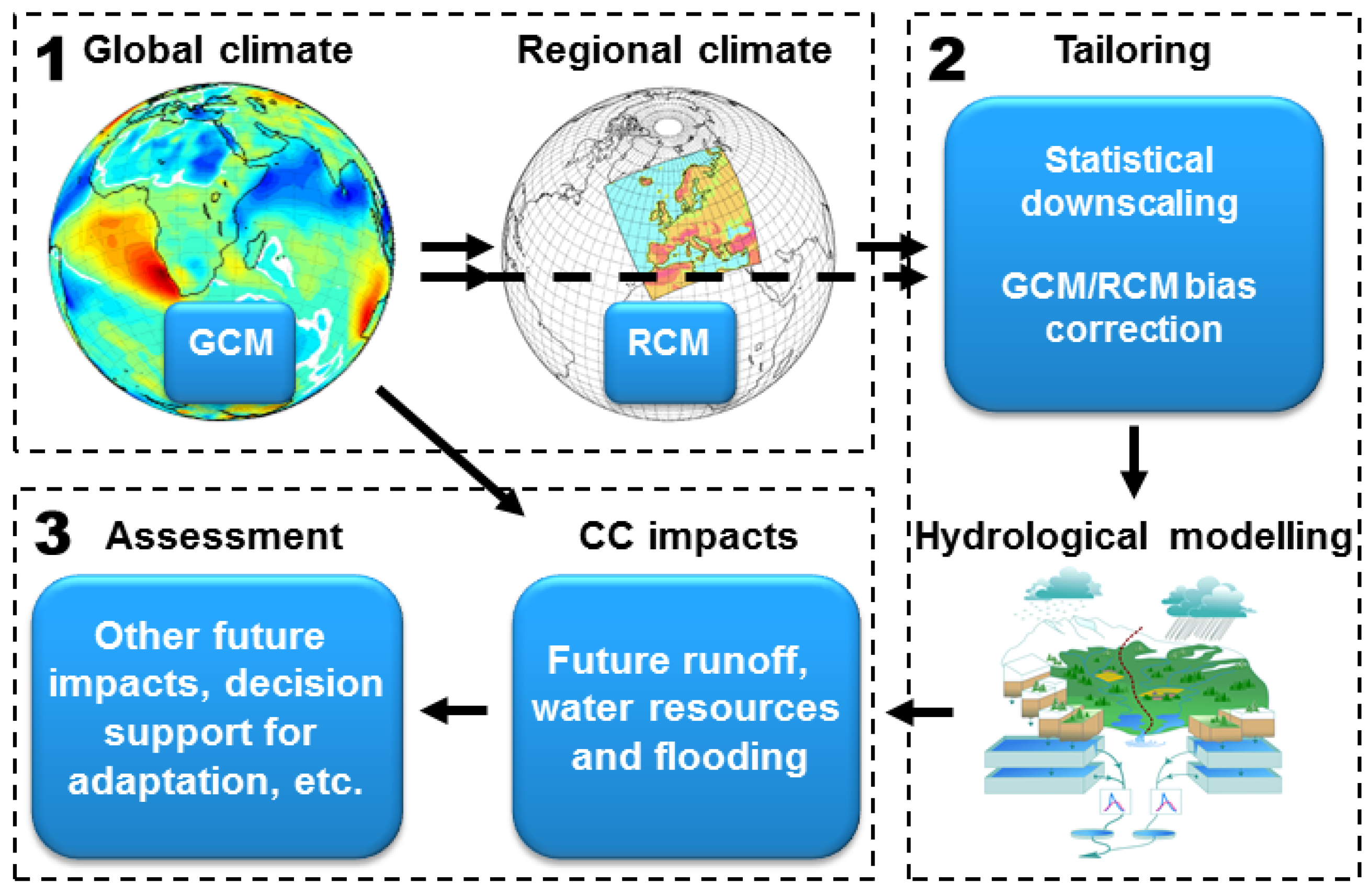
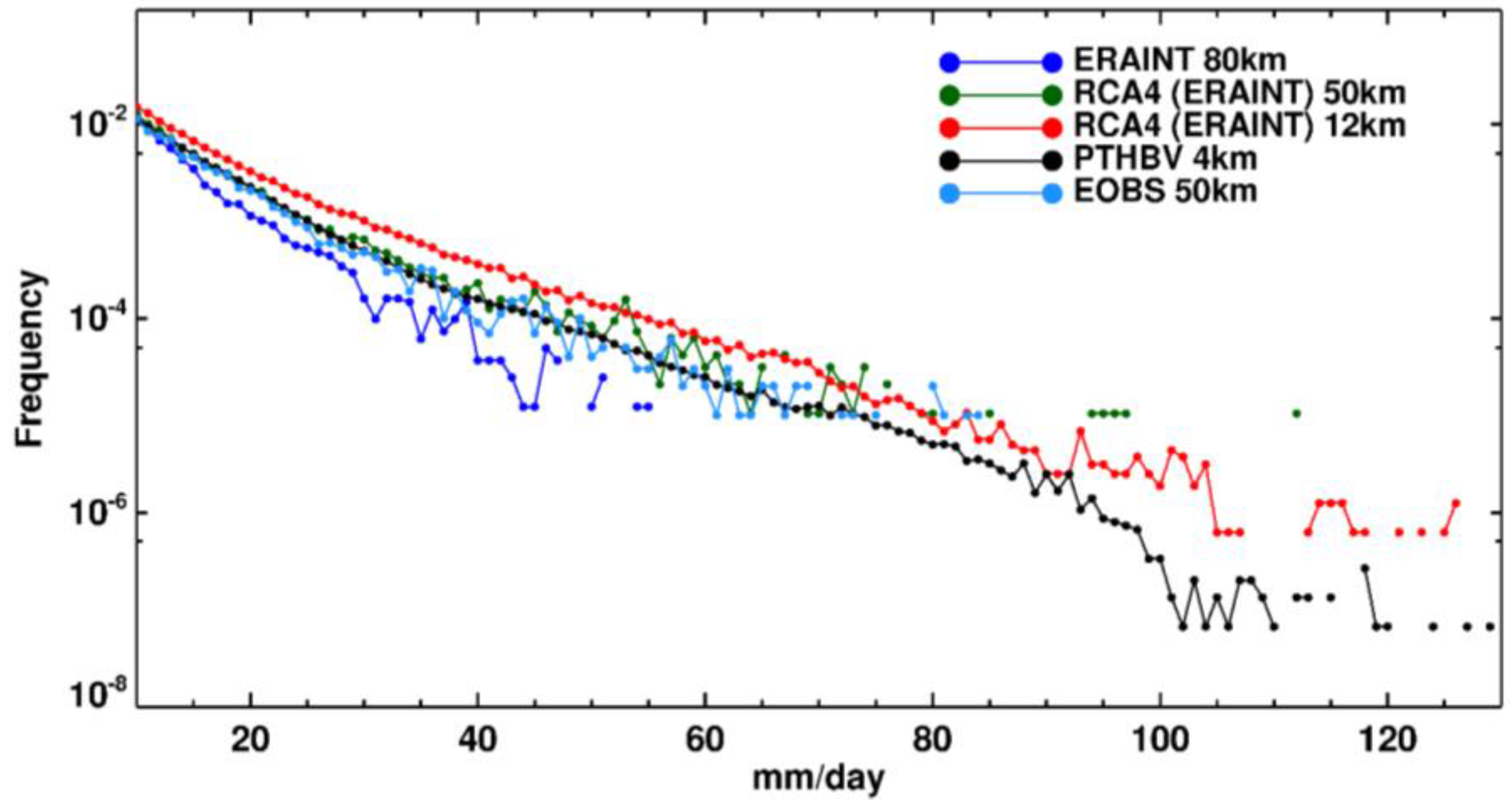
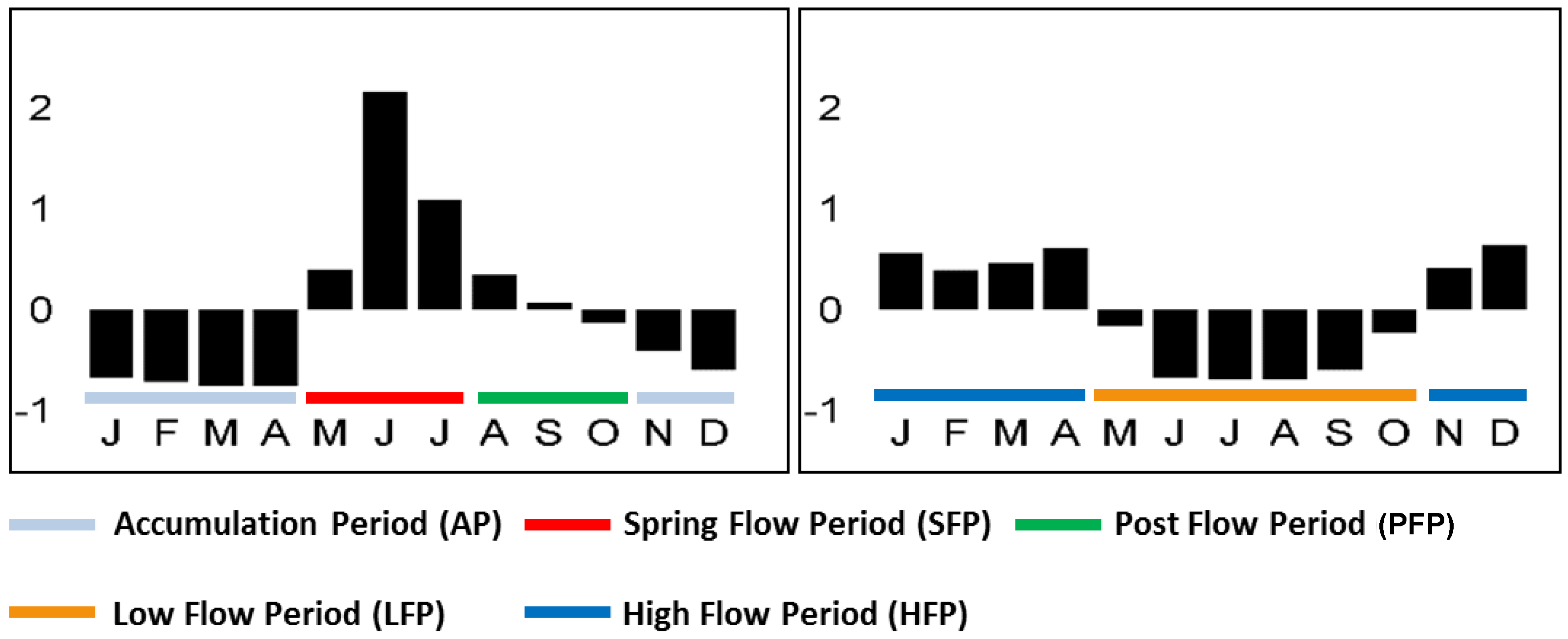
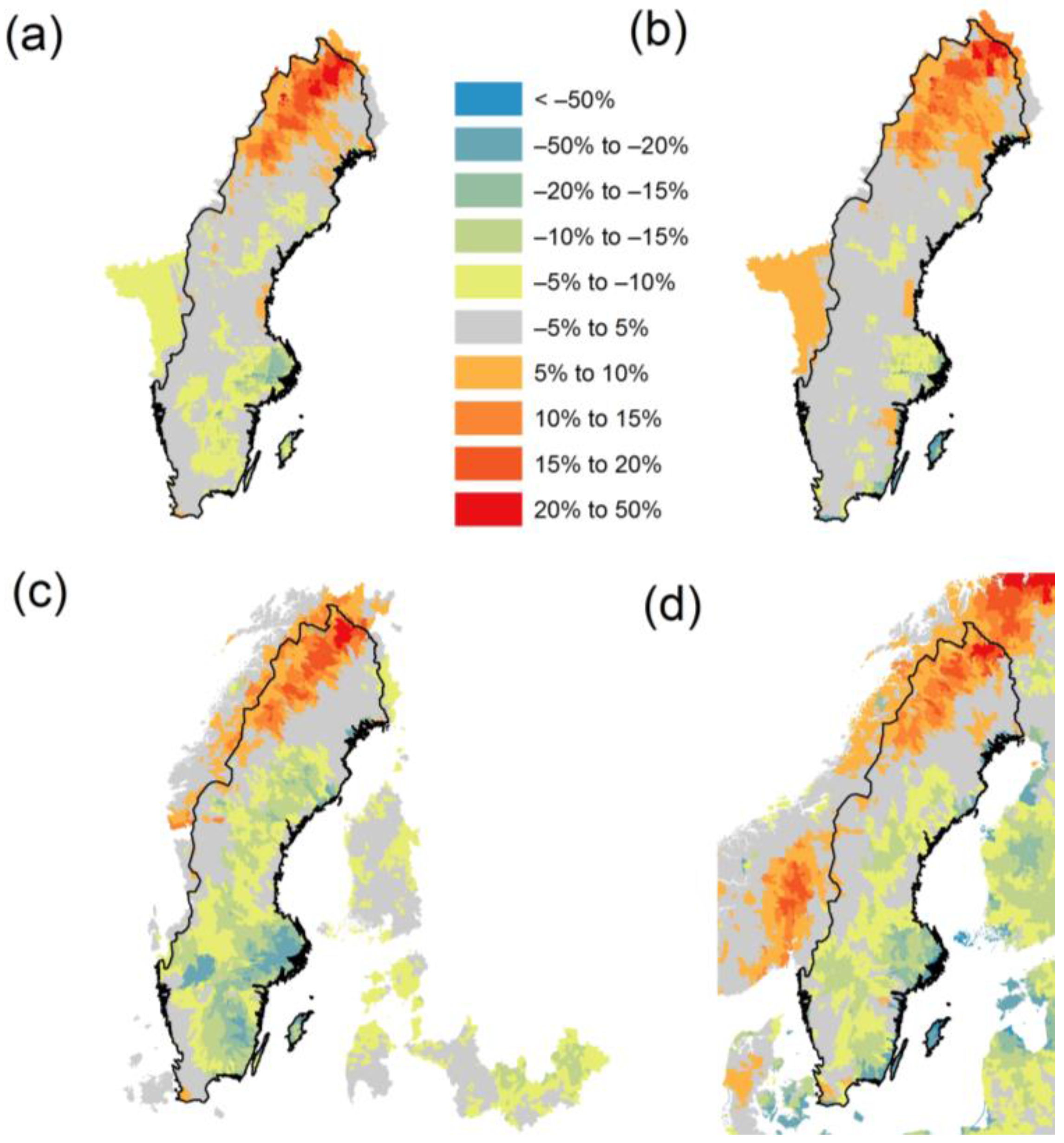
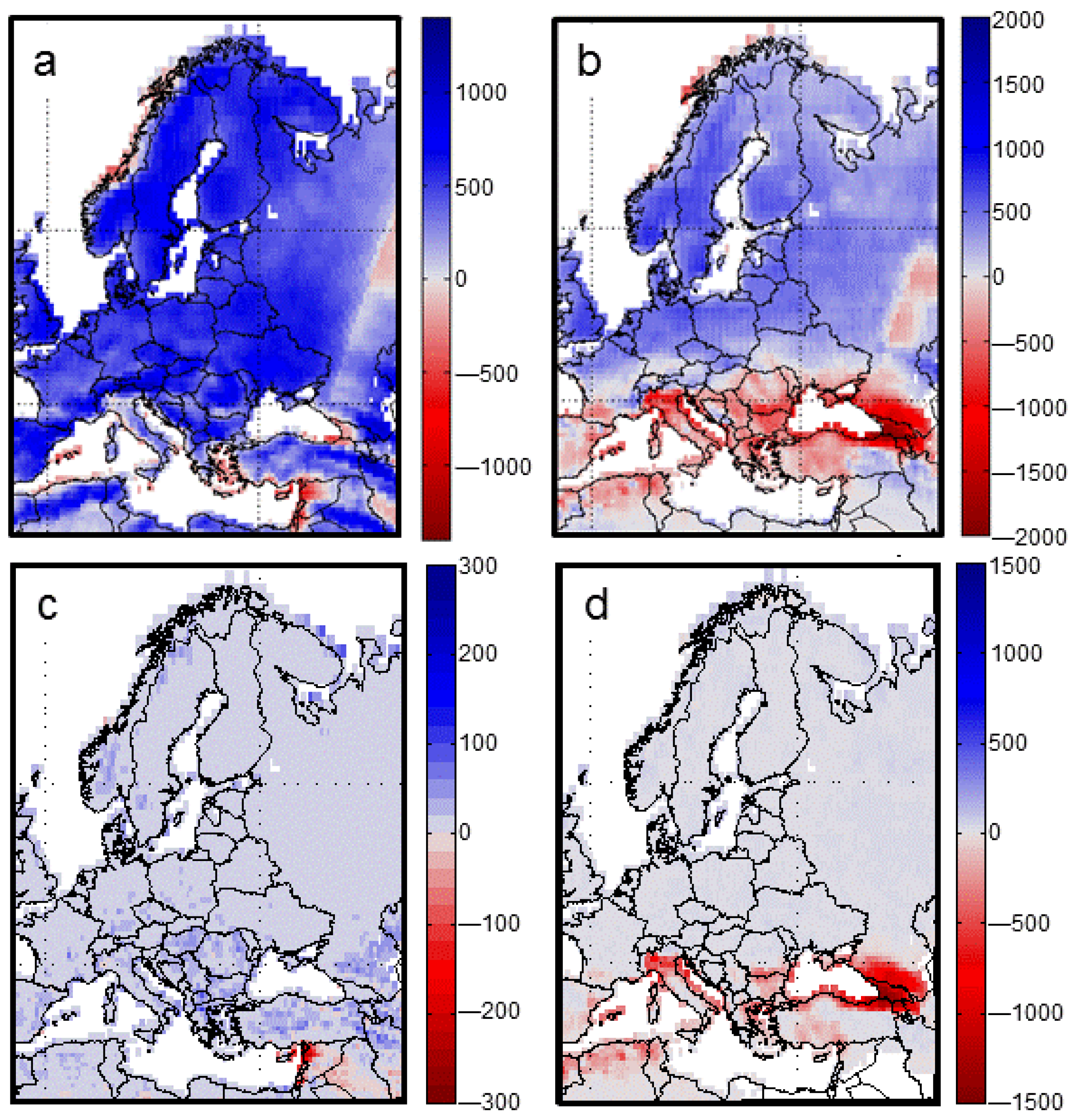
| Time Period | 1996–2010 | 2035–2049 | 2085–2099 | 1996–2010 | 2035–2049 | 2085–2099 |
|---|---|---|---|---|---|---|
| Precipitation Input | OBS | DC | DC | RCM | RCM | RCM |
| m | % Change | m | % Change | |||
| Mean ZCM | 0.62 | 6.7 | 1.8 | 0.93 | −6.5 | −13.6 |
| Min ZCM | 0.18 | −4.4 | −7.5 | 0.24 | 25.2 | 11.6 |
| Max ZCM | 1.29 | −4.8 | −4.4 | 1.59 | −15.9 | −35.9 |
| Scenario | 1 | 2 | 3 | 4 | 5 | 6 |
|---|---|---|---|---|---|---|
| Climate | Future 1 | future | future | future | future | future |
| Population | current | current | current | current | increased | increased |
| Land development | current | LID 2 | current | current | current area, more imperv. | larger area, urban sprawl |
| Traffic and buildings | current | current | less km driven | current | increase | more km driven |
| Newly legislated source controls | none | none | none | less Cu in brake pads | none | None |
| Runoff [%] | 9.4 | 1 | 9.4 | 9.4 | 19.8 | 20.3 |
| TSS [%] | 9.5 | 1.8 | 8.1 | 9.5 | 19.4 | 20.7 |
| Cu [%] | 9.3 | 2.4 | −2.6 | −18 | 37.5 | 32.8 |
| Zn [%] | 9.2 | 2.2 | 2.8 | 9.2 | 37.5 | 26.8 |
| AP | SFP | PFP | LFP | HFP | |
|---|---|---|---|---|---|
| S3 | NAO, AO, SCA, EA | NAO, AO, SCA | EAWR | - | - |
| S2 | NAO, AO, SCA, EA, EAWR | NAO, AO, SCA | - | - | - |
| S1 | EA, EAWR | NAO, SCA | POL | - | - |
| R1 | - | NAO, AO, EAWR | - | AO, EA, EAWR | EA, EAWR, POL |
| R2 | - | - | - | NAO, AO | AO, SCA, EA, EAWR |
© 2016 by the authors; licensee MDPI, Basel, Switzerland. This article is an open access article distributed under the terms and conditions of the Creative Commons Attribution (CC-BY) license (http://creativecommons.org/licenses/by/4.0/).
Share and Cite
Olsson, J.; Arheimer, B.; Borris, M.; Donnelly, C.; Foster, K.; Nikulin, G.; Persson, M.; Perttu, A.-M.; Uvo, C.B.; Viklander, M.; et al. Hydrological Climate Change Impact Assessment at Small and Large Scales: Key Messages from Recent Progress in Sweden. Climate 2016, 4, 39. https://doi.org/10.3390/cli4030039
Olsson J, Arheimer B, Borris M, Donnelly C, Foster K, Nikulin G, Persson M, Perttu A-M, Uvo CB, Viklander M, et al. Hydrological Climate Change Impact Assessment at Small and Large Scales: Key Messages from Recent Progress in Sweden. Climate. 2016; 4(3):39. https://doi.org/10.3390/cli4030039
Chicago/Turabian StyleOlsson, Jonas, Berit Arheimer, Matthias Borris, Chantal Donnelly, Kean Foster, Grigory Nikulin, Magnus Persson, Anna-Maria Perttu, Cintia B. Uvo, Maria Viklander, and et al. 2016. "Hydrological Climate Change Impact Assessment at Small and Large Scales: Key Messages from Recent Progress in Sweden" Climate 4, no. 3: 39. https://doi.org/10.3390/cli4030039
APA StyleOlsson, J., Arheimer, B., Borris, M., Donnelly, C., Foster, K., Nikulin, G., Persson, M., Perttu, A.-M., Uvo, C. B., Viklander, M., & Yang, W. (2016). Hydrological Climate Change Impact Assessment at Small and Large Scales: Key Messages from Recent Progress in Sweden. Climate, 4(3), 39. https://doi.org/10.3390/cli4030039






